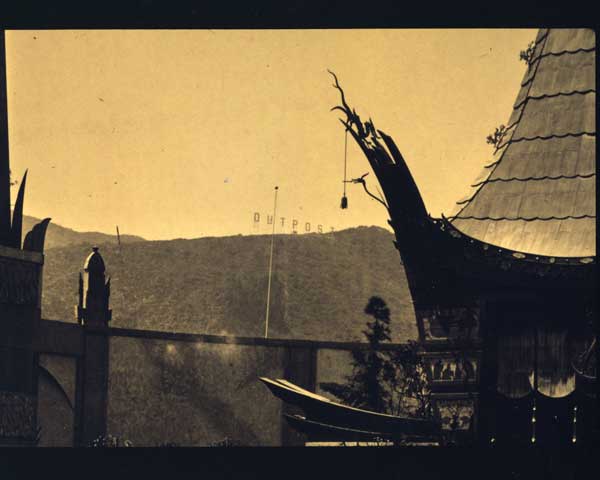HOLLYWOOD—When Ray told me that “back in the day” Outpost Estates had a sign that was bigger than the original Hollywood sign my jaw dropped. In all the time I’ve been nosing around the hills, no one had ever said anything about such a sign. Not a peep. Sure enough, there’s a picture to corroborate Ray’s tidbit.
I’ll back up a minute. I called Raymond Schuldenfrei. He’s a well-knownHollywood real estate guy (Re/Max Hollywood Hills). Try as I could to get Ray to talk about himself and the real estate business, he was all about how fascinating Outpost Estates is as a geographical location, and as a neighborhood. I expected he’d have lots of interesting stories about the hills and the people who have called the area home. As it turned out, Raymond had been the president (for many, many, many years) of the Outpost Estates Homeowners Association.
And when he told me about the red neon sign up on the hills over Outpost Estates that dwarfed the original Hollywood land sign, I was hooked. This past weekend, I met an old local who told me that the first patent for neon signs was granted to a Frenchman in 1910. They were used in all the movie marquees, and were ever so popular. So up went the red neon sign on the crest of the hill over Outpost Estates. A marketing ploy by the developer, and it was much more modern and efficient that the Hollywood land sign with its 40,000 light bulbs and the full time “bulb-keeper.” The local told me that the sign came down during World War II when blackouts at night were required. Too bad they didn’t just cut the power.
How did the name Outpost come about? Its origin goes back to General John C. Fremont, a military man and explorer. In the 1840s, the United Stateswas enmeshed in a political expansionist policy of “Manifest Destiny” where the United States borders should stretch from “ocean to ocean.” Fremont was the military commander of the American forces at the Battle of Campo de Cahuenga during the Mexican-American War. The view from Mulholland above Outpost Estates was the highest part of the Santa Monica Mountains. He used this site as his “outpost” to observe the movements of the Mexican troops during the short-lived battle.
In 1927, the developer of Outpost Estates, C. E. Toberman, announced that the land development was open. The Will F. Peck Company was laying white concrete for the roads. In fact if you look at the sidewalks in the area, sure enough you’ll see the Wm. Peck Company stamp embedded in the curbstone. Electricity had already been run underground, and king standard electroliers, which was a particular style of early electric street lights, had been installed.
All the homes in Outpost were required to be in the Mission style with tiled roofs to minimize the threat of fire to “one of the finest residential hillside developments” of its day. In 1928, the LA Times reported $700,000 of improvements in roads and amenities, which included the preservation of Sycamore groves under the supervision of a horticulturalist, had been completed. Houses in the upper area of Outpost Estates were built one at a time as the lots were purchased and the plans for each home approved.
If you drive up to Outpost Drive, you can immediately see the care that was taken in the original planning, which continues to be guarded by its residents with great pride.






